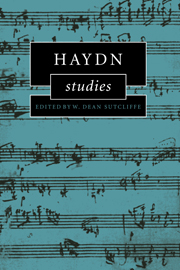Book contents
- Frontmatter
- Contents
- Preface
- Editor's note
- 1 The consequences of presumed innocence: the nineteenth-century reception of Joseph Haydn
- 2 Haydn's sacred vocal music and the aesthetics of salvation
- 3 Sentiment and sensibility in La vera costanza
- 4 Haydn as Romantic: a chemical experiment with instrumental music
- 5 Haydn's ‘Cours complet de la composition’ and the Sturm und Drang
- 6 Haydn's reversals: style change, gesture and the implication-realization model
- 7 Haydn's symphonies between Sturm und Drang and ‘Classical style’: art and entertainment
- 8 The Haydn piano trio: textual facts and textural principles
- 9 Papa Doc's recap caper: Haydn and temporal dyslexia
- 10 Haydn: the musicians' musician
- Index
5 - Haydn's ‘Cours complet de la composition’ and the Sturm und Drang
Published online by Cambridge University Press: 22 September 2009
- Frontmatter
- Contents
- Preface
- Editor's note
- 1 The consequences of presumed innocence: the nineteenth-century reception of Joseph Haydn
- 2 Haydn's sacred vocal music and the aesthetics of salvation
- 3 Sentiment and sensibility in La vera costanza
- 4 Haydn as Romantic: a chemical experiment with instrumental music
- 5 Haydn's ‘Cours complet de la composition’ and the Sturm und Drang
- 6 Haydn's reversals: style change, gesture and the implication-realization model
- 7 Haydn's symphonies between Sturm und Drang and ‘Classical style’: art and entertainment
- 8 The Haydn piano trio: textual facts and textural principles
- 9 Papa Doc's recap caper: Haydn and temporal dyslexia
- 10 Haydn: the musicians' musician
- Index
Summary
The phenomenon known as the Sturm und Drang figures prominently in most twentieth-century accounts of Haydn's development as a composer. Théodore de Wyzewa, writing in 1909, was the first to suggest an ‘extremely acute crisis’ in the composer's personal life, in the year 1772. This ‘crisis’, according to Wyzewa, manifested itself in a series of unusual minor-mode works, including Symphonies Nos. 44 (‘Trauer’), 45 (‘Farewell’) and 49 (‘Passione’), and the slightly earlier (1771) Sonata No. 33 in C minor. Wyzewa could not, however, identify any particular incident that would have caused such a ‘Romantic paroxysm’, so he invented one. These minor-mode works were ‘songs of sorrow’ occasioned by the death of a young woman. But ‘without a doubt’, Wyzewa concluded, the world would ‘never know the name of Haydn's “immortal beloved”’.
No one has ever taken Wyzewa's theory of an ‘immortal beloved’ for Haydn very seriously for the simple reason that there is no evidence to support it. Even Wyzewa himself seems to have found this hypothesis insufficient, for he went on in the same essay to offer a second, complementary explanation for these unusual symphonies. The ‘melancholy seriousness’ of these works, he argued, was also at least in part a product of the Zeitgeist and could be found in contemporaneous music by other composers as well, including Gluck, Mozart, C. P. E. Bach, Vanhal and Dittersdorf.
- Type
- Chapter
- Information
- Haydn Studies , pp. 152 - 176Publisher: Cambridge University PressPrint publication year: 1998
- 48
- Cited by

